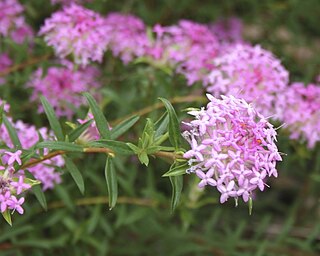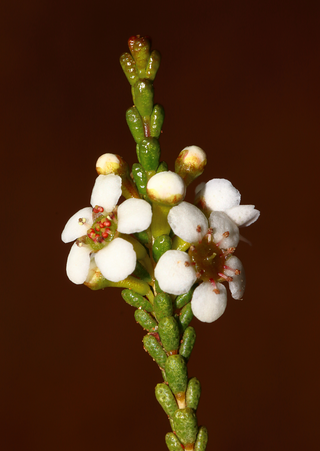
Pimelea rosea, commonly known as rose banjine, is a species of flowering plant in the family Thymelaeaceae and is endemic to the south-west of Western Australia. It is an erect shrub with narrowly elliptic leaves, and clusters of pale pink to reddish-purple flowers surrounded by 4 egg-shaped involucral bracts.
Micromyrtus acuta is a species of flowering plant in the myrtle family, Myrtaceae and is endemic to the southwest of Western Australia. It is an erect shrub with small, oblong leaves and small white flowers in the upper leaf axils.
Micromyrtus arenicola is a species of flowering plant in the myrtle family, Myrtaceae and is endemic to a small area in the southwest of Western Australia. It is an erect shrub with small, linear to narrowly egg-shaped leaves and small white flowers.
Micromyrtus barbata is a species of flowering plant in the family Myrtaceae and is endemic to inland areas of Western Australia. It is a shrub with small, overlapping, narrowly egg-shaped leaves and small white flowers arranged singly in upper leaf axils.

Micromyrtus clavata is a species of flowering plant in the family Myrtaceae and is endemic to inland Western Australia. It is an erect, compact or sprawling shrub with erect, egg-shaped leaves with the narrower end towards the base and small white flowers arranged singly in upper leaf axils.
Micromyrtus collina is a species of flowering plant in the myrtle family, Myrtaceae and is endemic to a small area in the southwest of Western Australia. It is an erect shrub with small, linear to narrowly egg-shaped leaves and small white flowers that turn pink as they age.
Thryptomene dampieri is a species of flowering plant in the family Myrtaceae and is endemic to the north-west of Western Australia. It is a low, spreading shrub with prostrate stems, broadly egg-shaped leaves with the narrower end towards the base, and pinkish flowers with five petals and ten stamens.
Thryptomene pinifolia is a species of flowering plant in the family Myrtaceae and is endemic to Kalbarri National Park in Western Australia. It is a shrub with linear leaves, and flowers with pale pinkish sepals and petals and seven or eight stamens.
Cryptandra beverleyensis is a species of flowering plant in the family Rhamnaceae and is endemic to the southwest of Western Australia. It is a shrub with narrowly oblong leaves and clusters of white, tube-shaped flowers.
Cryptandra distigma is a flowering plant in the family Rhamnaceae and is endemic to inland Western Australia. It is a shrub with oblong or narrowly egg-shaped leaves and clusters of white to cream-coloured, tube-shaped flowers.
Cryptandra exserta is a flowering plant in the family Rhamnaceae and is endemic to inland Western Australia. It is a shrub with narrowly oblong leaves and clusters of white, tube-shaped flowers.
Cryptandra imbricata is a flowering plant in the family Rhamnaceae and is endemic to the southwest of Western Australia. It is a spreading shrub with spiny, interlaced branchlets, narrowly oblong to linear leaves and spike-like clusters of white, tube-shaped flowers.
Cryptandra inconspicua is a flowering plant in the family Rhamnaceae and is endemic to the southwest of Western Australia. It is a small, spreading shrub with narrowly elliptic to egg-shaped leaves and head-like clusters of white, tube-shaped flowers.
Cryptandra intonsa is a flowering plant in the family Rhamnaceae and is endemic to inland Western Australia. It is an erect or spreading shrub with linear to narrowly oblong leaves and white or cream-coloured, tube-shaped flowers arranged in head-like clusters.
Stenanthemum mediale is a species of flowering plant in the family Rhamnaceae and is endemic to inland Western Australia. It is an erect shrub with densely hairy young stems, egg-shaped leaves and densely hairy heads of silvery to rust-coloured flowers.
Cryptandra micrantha is a flowering plant in the family Rhamnaceae and is endemic to the southwest of Western Australia. It is a prostrate or upright shrub with spiny branchlets, narrowly oblong to elliptic leaves and dense clusters of white or cream-coloured, tube-shaped flowers.
Cryptandra monticola is a flowering plant in the family Rhamnaceae and is endemic to the south-west of Western Australia. It is an erect or spreading shrub with linear or narrowly oblong to elliptic leaves and head-like clusters of white, tube-shaped flowers.
Stenanthemum patens is a species of flowering plant in the family Rhamnaceae and is endemic to the inland of Western Australia. It is a small shrub with densely hairy young stems and a few spines, egg-shaped to broadly egg-shaped leaves with the narrower end towards the base, and densely hairy clusters of tube-shaped flowers.
Cryptandra stellulata is a flowering plant in the family Rhamnaceae and is endemic to the southwest of Western Australia. It is a shrub with spiny branches, narrowly oblong to linear leaves and spike-like clusters of 2 to 12 white, tube-shaped flowers.
Cryptandra wilsonii is a flowering plant in the family Rhamnaceae and is endemic to the south-west of Western Australia. It is a shrub with hairy young stems, oblong to narrowly oblong leaves and clusters of white, tube-shaped flowers arranged in small clusters.


